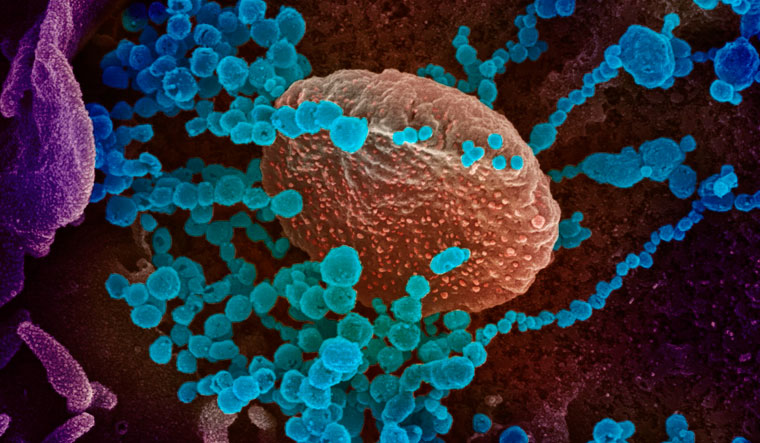The pandemic has savaged humanity for 18 months. But, the origin of the virus, Sars-CoV-2, also called CoV2, remains to be confirmed. Deliberate efforts have been made, from the beginning, to attribute it to natural evolution. Piles of details available, however, suggest the alternate possibility of the virus having escaped from a laboratory of the Wuhan Institute of Virology (WIV).
CoV2’s genetic details (genome) were published by a Shanghai laboratory on January 10, 2020. Soon, WIV revealed, in a paper published in Nature on February 3, that it had a virus, named RaTG13, in its possession. It claimed that the virus matched 96.2 per cent with CoV2 and was its closest known relative.
Without giving adequate details about RaTG13’s past or the lab's earlier research on it, WIV mentioned that the virus sample had been collected from bat faeces in Yunnan in 2013. Further, the paper implied that WIV had worked on its entire genome only after the Covid-19 outbreak. Its research collaborator, Dr Peter Daszak, head of EcoHealth Alliance, New York, confirmed in an interview that RaTG13 was not researched prior to the outbreak of the pandemic.
Researchers worldwide soon found out that WIV had changed the name of the virus to RaTG13, just before the publication of the paper. The earlier name was RaBtCoV/4991, and this was confirmed by a third party from China. Going through WIV’s publications, researchers discovered that the lab had researched on RaBtCoV/4991 in 2016 and in 2018. And researchers found that, based on 2016 details, RaBtCoV/4991 alarmingly matched 98.9% with CoV2.
In July 2020, in an emailed reply to the journal Science, WIV admitted that the name RaBtCoV/4991 was changed to RaTG13 and they were the same virus. It said it had researched on the genome of RaBtCoV/4991 in 2018 also, and stated that no more of this virus sample was left after the lab's 2018 work on it. If no sample was left, how did it work out the details of RaGT13’s genome after the outbreak of the pandemic?
Several other inconsistencies surround RaTG13. It was first stated that the virus sample was taken from bat faeces. But when the genetic details were published with the gene bank in February 2020, it was stated that the sample was from broncho-alveolar lavage fluids. Further, though its source was ascribed to a bat, RaTG13 astonishingly was found unable to attach itself to receptors of bat’s cells. On the other hand, like CoV2, it was found capable of attaching to human cell receptors (ACE2). Its molecular structure, at the site where it precisely attaches, is quite akin to CoV2’s structure.
In October 2020, two Indian scientists established that RaBtCoV/4991, collected from Yunnan in 2013, was from the same copper mineshaft in which six miners had developed acute respiratory distress syndrome in 2012 while clearing that mineshaft full of bats. Three of the miners died. At no point did China report this incident, but its details were found in the thesis of a medical student. WIV claimed, post-outbreak, that the miners suffered from a fungal infection. The symptoms and treatment, however, were similar to those of Covid-19 patients. The thesis confirmed that laboratory samples from the miners had been sent to the WIV and it concluded that the miners’ infection was from a Sars-like bat coronavirus.
Ultimately, WIV broke ten months of its stony silence on RaTG13's significant details and, in December 2020, issued corrections and amendments to its paper in Nature. It accepted the linkage of the sample to the same mineshaft where mine workers had developed respiratory sickness. It also retracted its claim that the RaTG13 genome was worked out post-outbreak and admitted that its paper in Nature was based on past research only. Evidently, WIV had been researching on this virus during all this period without publishing crucial details.
With so much of misleads, vacillations and hoodwinking, can the details furnished by WIV, or for that matter by China, be trusted?
WIV holds the answer to a key question: How did RaTG13 cover the genetic difference of about 4 per cent that exists between it and CoV2? In nature it takes decades, but in laboratories it can be made to undergo changes much faster, under selection pressure from immune system or antiviral drugs. Or, it could be manipulated with seamless means in no time. And clearly, CoV2 has something more in its structure that RaTG13 lacks.
Also read
- How an Indian scientist couple worked to trace origin, course of COVID-19
- Why 'gain of function' research must be stopped: Monali Rahulkar
- The real virus came from Zhoushan and Chinese military found it: Dr Li-Meng Yan
- Indian scientists see substance in lab leak theory
- As Biden wants to probe COVID-19 origin, China asks him to look closer to home
- Chinese are unapologetic over Covid originating in their country
- Wuhan is back to normal, but China remains silent about controversial lab
A special structure at key location in CoV2’s spike protein has been highlighted by some scientists as a “smoking gun”. Called furin cleavage site (FCS), it is a most crucial structure, as it has not only made CoV2 much more infectious but also enhanced its ferocity. None of the other Sars-like bat coronaviruses has FCS.
The ingredients used in the FCS’s structure (amino acids) are unique, in the sense that coronaviruses do not make use of such components (nucleotides) in that combination anywhere in this zone. But such identical combinations exist commonly in similar structures in the human body. Scientists, including those from WIV, have been making such structures in laboratories in their experiments. How CoV2 got FCS—an unprecedented structure, at a most crucial location, with distinct composition and from unique ingredients—is easier to explain by pointing to lab manipulation than to natural evolution. The critics may, however, say that viruses, like nature, are unpredictable. But then, isn't it stretching the probabilities too far?
The possibility of CoV2 coming from nature has hardly anything in its support, except that the jumping of viruses from animals into humans has not been uncommon. But, in this case, no intermediate animal host has been found so far. And, surprisingly, CoV2 has not been found infecting the bats—it should have, had it come directly from bats.
Moreover, the jumping of an animal virus into humans is a gradual process in which the virus makes repeated efforts and undergoes structural changes for efficient transmission into humans. As a result, the virus’s intermediate stages or antibodies against it become traceable in humans or animals. No such clues, however, have been reported so far. On the contrary, CoV2 has hit the population right from beginning with 10 to 20 times higher transmission efficiency than the Sars virus of 2003.
WIV has evidently hidden more than it has revealed, the WHO-China joint investigation report has been found inadequate, and the US government's fact-sheet has linked the People's Liberation Army's involvement at WIV. Therefore, only a forensic investigation in terms of Biological Weapons Convention of 1972 can unearth the truth. For one thing is certain: the lab-leak possibility just can’t be wished away. Hopefully, science will prevail over obduracy, and the tormented humanity will get to know how and from where the depredatory virus came.
The author is a microbiologist, an expert on animal viruses, and trained in biological warfare detection and protection.



